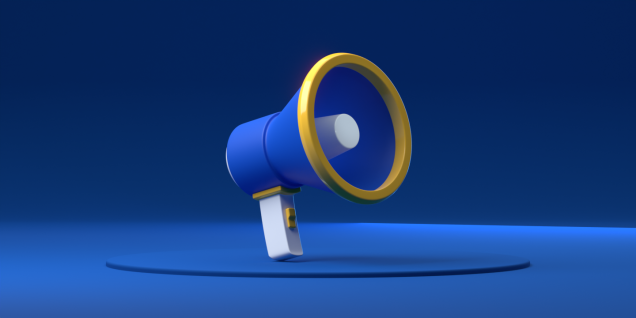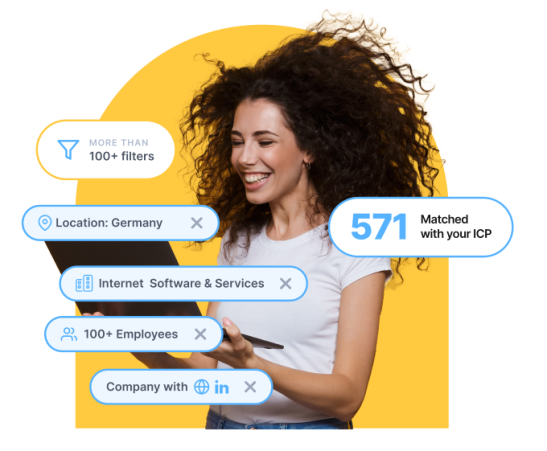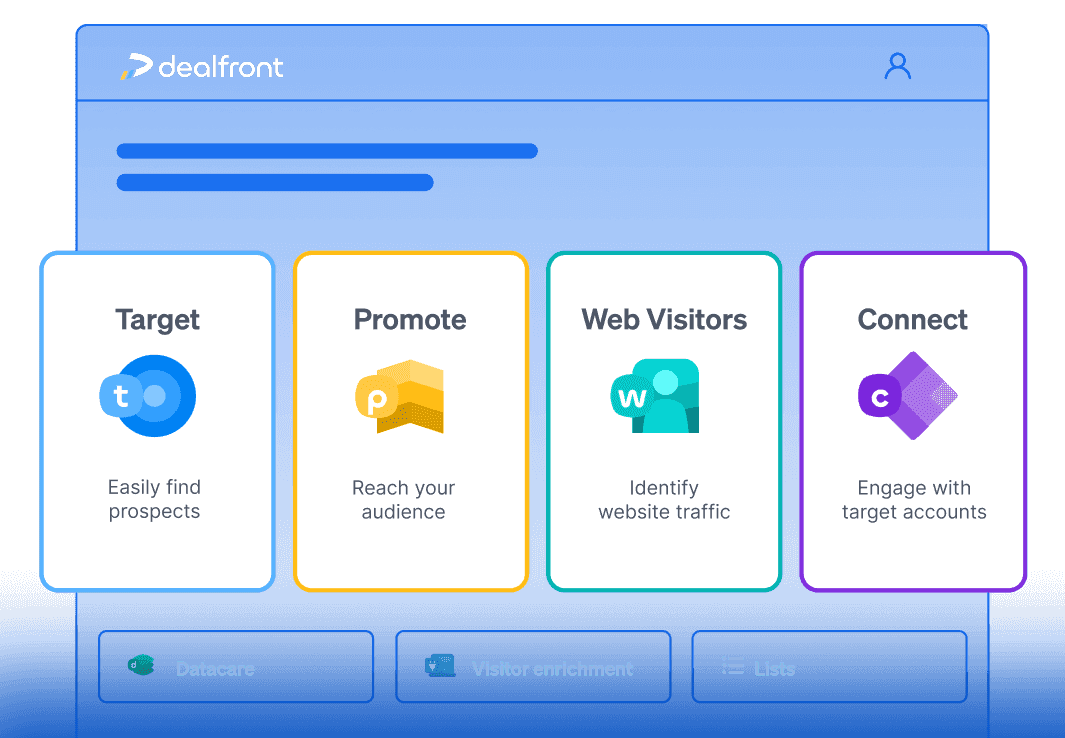Planning, strategizing and executing B2B (business-to-business) marketing plans can make even the most seasoned marketers sweat. Figuring out the who, what, when, where, and how can be tricky, but never impossible. But what exactly is B2B marketing?
Getting the “who” of your strategy right will make or break your success, so we’ll dig deep to give you the knowledge you’ll need to win at B2B marketing. When you’re done, you’ll be able to:
understand the differences between B2B and B2C marketing
learn why and how B2B marketing can elevate your business wins
create effective strategies and execute best practices to serve your customers
Let’s begin with a breakdown of the differences between B2B and B2C marketing:
What is the difference between B2B and B2C marketing?
Where B2B marketing targets companies and organizations, business-to-consumer (B2C) marketing targets individual customers. That makes the difference between the two the target audience.
B2B marketing:
The decision-makers within a company making purchases for their companies.
The organization is the target audience and end consumer of the product or service.
B2C marketing:
The people who make purchase decisions for themselves.
The individual is the target audience and the end consumer of the product or service.
Other factors differentiating B2B from B2C marketing include:
Communication tactics
B2B marketing communication focuses on satisfying the information needs of the target customer. That means your B2B communication should be:
Instructive
Data-driven
Problem-oriented
Goal-oriented
Long-term
B2C communication focuses on satisfying the emotional and social needs of the target customer, so your B2C communication should be:
Entertaining
Benefits-driven
Illustrate instant gratification
Show social influence
You could say that the major difference between B2B and B2C communication tactics is that B2C communication focuses on enhancing brand awareness while B2B communication prioritizes customer satisfaction.
Personalization
Given that B2B products are expensive, B2B customers demand personalized attention from marketers to ensure they get the best value for their money. That’s why the most effective B2B marketing is super-personalized.
B2C marketing focuses more on mass appeal than personalization. This is because B2C marketers target a wider customer base, making personalizing each customer's message difficult.
Emotional vs. functional appeal
B2C marketing seeks to capitalize on customers’ emotions to persuade them to purchase. B2C marketers leverage emotional marketing strategies to influence purchase decisions. These strategies include:
Storytelling
Color psychology
Aspirational or inspirational marketing
However, B2B marketers use functional marketing strategies like explaining product data and metrics to influence a customer's buying decision. This sits well with B2B customers, who prioritize a product’s functionality and efficiency over other secondary factors like aesthetics that sway emotions.
Experienced B2B marketers who know their B2B buyers well often utilize both functional and emotive marketing strategies.
Despite the differences between B2B and B2C marketing, both serve a common purpose—to attract leads and convert them to returning customers.
Naturally, B2B customers take more time to convert as a chain of approvals is often involved before a purchase decision is made. You must understand the B2B buyer’s journey to know what type of marketing content to apply at different points to optimize the buying journey.
The B2B marketing funnel
The B2B marketing funnel describes the purchase journey from the first point of contact when prospective customers interact with a brand's website to the last point when they buy a product or service.

Creating a B2B marketing funnel helps you understand the customers’ pain points at each stage. You can use that to deliver customized solutions through various B2B marketing content. The typical B2B marketing funnel has these three stages:
Top of the funnel (TOFU)
TOFU, also called the awareness stage, is the first stage of the marketing funnel. Prospective customers recognize the challenges within their businesses and start looking for solutions.
At this stage, prospects are all over the place shopping for solutions but aren’t ready to commit to a particular brand or product. Thus, your main goal in the TOFU stage is creating brand awareness and generating more leads. This helps more prospects discover your company’s offerings online and continue learning more about your solutions.
Remember, prospects have no attachment to your brand or product at this point. You must capture and retain their attention by creating informational content that addresses their existing challenges head-on. Two of the most effective techniques for raising brand awareness in the TOFU stage are:
Generating organic awareness
B2B buyers do extensive independent research before settling on a solution, brand, or product. In fact, B2B buyers only initiate contact after they're 57%-70% through their buying research. This means they consume tons of content to study and compare various solutions.
All through their research phase, B2B buyers are looking for a brand they can trust. This is where organic awareness comes in.
Organic awareness indicates your website has achieved organic ranking. Your potential customers know it takes much effort and time to rank organically. So, if your brand has a high organic ranking, it positions your company as an industry leader in the eyes of B2B buyers. This raises their trust levels in your company.
That’s why you should focus on generating organic awareness at the TOFU stage by:
Publishing blog posts
Posting how-to YouTube videos
Creating landing pages
Doing search engine optimization (SEO).
Generating paid awareness
Paid awareness comes from paid rankings. It involves paying for keyword-based advertisements on social media and Google to rank high on the search engine result page (SERP). You may then wonder why you should pay for ads, while 84% of B2B decision-makers prefer to learn about a brand by reading multiple articles over advertisements.
The simple answer is: expedited visibility.
By using paid awareness, you can reach as many prospects as possible in the shortest time. This helps you enhance brand awareness, which is the primary goal at the TOFU stage.
Paid awareness is even more vital when marketing a new product in a competitive market. As a best practice, you should run your paid awareness campaigns alongside organic efforts to get the ideal results.
The TOFU stage is critical because it lays the foundation for the buyer’s journey. If you lose prospects at this stage, all your subsequent efforts go down the drain. That’s why you must create top-notch TOFU content that helps you establish topical authority and sell your brand as a thought leader. It explains why 95% of marketers create TOFU content.
Middle of the funnel ( MOFU)
MOFU, also called the consideration stage, is the second B2B marketing funnel stage. Prospects in the MOFU stage have established you’re a subject matter expert from reading your TOFU content, and they begin to consider your brand's solutions seriously. This is where you introduce your product and show its value proposition. But how?
By creating MOFU content like:
White papers
Case studies
Webinars
Industry reports
Product videos
Quizzes or surveys
Your goal at the MOFU stage is to nurture leads and gradually build purchase intent. Seeing that B2B buyers are more concerned about enhancing their business outcomes, your MOFU content should demonstrate how your product improves their processes.
At the MOFU stage, prospects aren’t ready to buy and are looking for more context. At this point, they’re likely browsing other options but haven’t settled on one. Your MOFU content should show B2B buyers your product or service’s unique benefits, and how they help achieve their company goals.
Bottom of the funnel (BOFU)
BOFU, also called the decision stage, is the last stage where the prospect is ready to make a buying decision or initiate the purchase process. At the BOFU stage, prospects show two critical qualities:
They already recognize your brand as a market leader from reading your TOFU content.
They're aware of your product value from reading your MOFU content.
However, they’ve likely done the same with your competitors and shortlisted a few. This means you need BOFU content to persuade them to make a purchase decision in favor of your brand. In short, your sales team is looking for a close. Some of the techniques you can use to step up conversion include:
Free strategy consultation calls
Free trial with unlimited access
Interactive call-to-actions (CTAs)
Free quotes and price estimates
Bundled pricing
The BOFU stage calls for hyper-personalization to convert your target prospect. B2B buyers must be convinced your product or solution is tailored to their existing and future pain points.
Typically, B2B buyers prefer a dedicated account manager to work with. So, you may want a sales team member (who would later transition to an account manager) to take over once a B2B buyer initiates contact at the TOFU stage.
B2B marketing channels
Creating B2B marketing content, whether TOFU, MOFU, or BOFU, is an ongoing process, not a set-and-forget strategy. But even if you consistently create top-notch content but fail to distribute it on the channels your target audience are, you won't get value.
While tech advancements will likely create new marketing channels in the future, these channels are the most effective for B2B marketing today.
Content marketing
Content marketing is creating and distributing valuable, relevant, and informative content to a target audience to influence profitable customer action. Content marketing is so effective that 73% of B2B marketers actively leverage it in their overall B2B marketing strategy.
These marketers will tell you that choosing the right type of content to use in different marketing campaigns is mission-critical. Which brings us to the different types of content involved in content marketing.
Podcast
Podcasts are audio programs that include a series of spoken words discussing a specific topic, idea, theme, or random topic. Podcasts are a great way for B2B audiences to consume your content because they can listen while commuting to work. Not only are you providing them with a way to learn and have your brand in mind, but it also saves them time.
There are two ways your B2B brand can benefit from podcasts:
Find a relevant podcast within your target audience and run ads
Broadcast your own show
Either way, you’ll be happy to know that podcasts yield results. A 2022 study by Tapestry on behalf of the Guardian found that 65% of podcast listeners pay attention to podcast ads.
The great news is that the same study found 51% of weekly podcast listeners said podcast ads triggered their desire to buy a brand’s product. Podcasts are a top traffic and lead-generating channel you should include in your content marketing strategy.
White papers
White papers play a fundamental role in B2B marketing because they explain a brand’s value proposition in detail, and back it up with real-time data and statistics. You can create three types of white papers for B2B marketing purposes. These are:
Backgrounders: Explain complex and technical product information in a reader-friendly format.
Numbered lists: Highlight the key functions of a product or service using many headings and bullet points.
Problem/solution: Pinpoint specific problems prospects face and provide data-driven solutions.
White papers help attract customers early, particularly if your product or service offers an innovative solution to a challenge that has troubled your niche for a long time.
Webinars
Webinars are online events that B2B marketers organize targeting a particular audience. Webinars use web conferencing software to facilitate live-stream encounters between marketers and their prospects. Webinar marketing is a more interactive way of marketing your brand, as prospects can ask questions “in person”, and get instant answers.
Case studies
Convincing B2B buyers that your product is a game-changer can be a hard sell if you don’t show them a real-life instance in which your product/service has lived up to its billing. This is where case studies come in.
Case studies are comprehensive illustrations of how your product or service helped a particular customer(s) achieve a profitable business outcome. Case studies help you show a product’s value in real-life use cases other than promising prospects on paper only.
Infographics
Infographics are visually appealing formats for presenting complex B2B processes, ideas, or products to your target customers. B2B marketers use infographics to present complex and long-winded ideas instead of long-form blogs. Because infographics are easy to understand, they promote 78% more information retention. This explains why 67% of B2B marketers leverage infographics.
Testimonials
Testimonials and reviews yield much influence on a customer’s purchase decision. One reason is that they are user-generated, making them more authentic and unbiased. Thus, it's no surprise B2B buyers say reviews influence their buying decisions way more than vendor-generated content like case studies or ads.
Landing page
Landing pages are website pages that aim to convert web visitors into leads. You can customize your landing pages to target customers across each marketing funnel stage. The ideal landing page should have a clear CTA, persuasive copy explaining the value proposition, and engaging visuals.
Social media marketing (SMM)
Social media platforms like YouTube, LinkedIn, Instagram, Twitter, and Facebook are slowly taking over B2B marketing as more B2B buyers embrace these platforms. Today, social media influences the purchase decisions of about 40% of B2B buyers.
To succeed in SMM, you must know which platforms your target audience is fond of and zero in on those channels. You can establish your customers’ favorite social media channels by:
Developing your ideal customer profile (ICP)
Studying your customer relationship management (CRM) data
Asking customers through surveys and questionnaires
Review the channels your competitors are using
With over 61 million companies on LinkedIn, there’s a high chance your B2B prospects are on LinkedIn. In fact, B2B marketers cite LinkedIn as the source of 80% of their social media leads. Make sure that your SMM strategy is in line with the terms and conditions of your chosen social media platform.
SEO (Search Engine Optimization)
SEO is the most effective way of increasing organic traffic across all stages of your B2B sales cycle. Your B2B SEO strategy should encompass these four pillars:
Off-page SEO
On-page SEO
Content SEO
Technical SEO
Because SEO is time and skill-intensive, B2B marketers often outsource SEO or hire an in-house SEO expert.
Email marketing
B2B email marketing is more intricate because B2B buyers are usually pressed for time compared to B2C buyers. As such, every email you send to your B2B prospects should:
Be short and precise
Not contain clickbait
Have a personalized subject line
Include social proof
These factors help boost email open rate and click-through rate. To simplify your email marketing processes, consider using reliable email marketing software to automate your email marketing functions.
With B2B email marketing, you must study your target audience down to the department level. Study a company’s chain of command in a purchase decision and target each decision maker with customized emails.
PPC
Pay-per-click (PPC) advertising involves displaying short and customized ads to search engine users who search for your products or services online. The beauty of PPC is that you only pay when a prospect clicks your ad. PPC ads yield more qualified B2B prospects, lowering the overall time required to generate quality leads and the cost of acquiring new customers.
Programmatic display advertising
Programmatic advertising is utilizing software to bid and pay for ad space. Programmatic marketing gives you the opportunity to show your ad to a specific audience at a specific time and context. It allows you to channel your marketing money where your B2B customer is.
Event marketing
As much as most B2B marketing activities happen online, offline marketing strategies still work. B2B event marketing capitalizes on offline marketing opportunities including:
Executive conferences
Trade show marketing
VIP dinners
Lunch and learn events
B2B event marketing makes in-person marketing possible. In-person marketing is sometimes the secret sauce of closing B2B decision-makers who aren’t readily available online or prefer face-to-face marketing.
Video marketing
Explainer videos, product videos, social media videos, and interview videos help your B2B buyers learn and understand your brand’s offerings comprehensively. Videos are more engaging than text-based content and are more successful at retaining users’ attention. Today, 91% of businesses leverage video as a marketing tool.
The benefits of B2B marketing
Techjury says the B2B industry will spend $15 billion on digital ads in 2023. If B2B companies are shelling out top dollar on digital marketing, it's evident online marketing brings in first-class perks you wouldn't want to miss. Some top benefits of digital marketing include:
Puts you where your customers are—online
Today, millennials make 73% of all B2B purchase decisions. And one fact about millennials is that the internet is their natural habitat. Therefore, marketing your B2B brand online puts your products and services in the sights of B2B decision-makers.
Helps you build awareness
Even if you have the most innovative product or service, it will only help your business if prospects know it exists. Digital marketing helps increase brand and product awareness better than any well-coordinated word-of-mouth marketing campaign.
Without digital marketing, you would only have foot traffic (i.e., customers physically visiting your establishment, tradeshow booth, and any other place your brand has a physical presence). But with online marketing, you get digital traffic through your website.
Helps you refine product quality by collecting customer feedback
Digital marketing supports customer feedback collection methods like online surveys and product reviews. Acting on customer feedback data shows you the flaws you must correct and the features you should introduce to improve your product.
Helps you establish and cultivate online customer relationships to prevent churn
The customer journey of a B2B buyer doesn’t stop after purchase, as is sometimes the case with B2C buyers. B2B buyers require extended after-sales support to get to value quickly and meet their set goals. As such, you must maintain a robust customer relationship with your existing customers to keep them subscribed.
B2B marketing best practices
Think of all the dollars, human resources, and time needed to develop a winning B2B marketing campaign. Indeed, the last thing you would want is for your marketing campaign to fall short due to poor execution. To avoid undesirable outcomes, follow these B2B marketing best practices:
Identify your target buyers through your ideal client profile (ICP), buyer personas, and total available market (TAM): This helps you customize your marketing communication to speak to potential customers rather than following spray-and-pray marketing techniques.
Have an omnichannel strategy: Establish the social media channels your prospective customers use and build an active profile. This way, you can simultaneously deliver solutions to multiple customers on different channels.
Qualify leads: Not every lead you get will convert to a customer. That’s why you should qualify leads so you channel your marketing efforts toward potential customers. A quality lead should:
Have an immediate or upcoming need for your product
Have the capacity to pay for your products and services
Have the authority to make a purchase decision or heavily influence the decision
Be accessible
Nurture and educate your leads and buyers continuously: B2B products have a long sales cycle, so you should aim to build a continuous relationship with your leads instead of a one-off encounter. When they become customers, keep them engaged and try to convert them to brand ambassadors who bring in word-of-mouth referrals.
Measure results and course-correct: Monitor your B2B marketing campaign and measure them against your KPIs (Key Performance Indicators). Make adjustments where you find performance gaps.
B2B marketing examples
Here are three top-tier B2B companies that have mastered the art of B2B digital marketing and achieved remarkable results:
Kindred Healthcare's account-based marketing campaign
The healthcare sector is one of the most sensitive B2B markets thanks to the strict regulations guiding it. Thus, referrals are a reliable source of new B2B customers because trust and credibility are pre-established.
Kindred Healthcare, a post-acute care provider to hospitals and healthcare systems, capitalized on the power of referral business through their account-based digital marketing campaign focused solely on referral needs.
By creating interactive digital experiences and engaging content for referral sources, Kindred managed:
An impressive 40:1 return on investment
A 30% increase in email click-through rates
Over 250 fresh referral sources
Lenovo's email marketing campaign—LEAP Rewards
Lenovo's LEAP program offered Lenovo partner firms and resellers LEAP Points for eligible Lenovo sales. This program utilized email marketing to educate and engage Lenovo's B2B partners aiming to increase Lenovo's overall digital sales.
As a result, Lenovo noted that participants of the LEAP program recorded an 8 to 10 times sales increase, contributing to 57% of Lenovo's non-direct revenue. This was a huge win that added to Lenovo's B2C sales.
Drift's employee advocacy marketing campaign
In 2020 when automation started impacting B2B marketing campaigns more heavily, Drift decided to keep and enhance the human touch in their B2B campaigns. Drift turned to its staff to lead its employee advocacy campaign through various employee-centric programs like the Power User Spotlight. This campaign helped Drift become top-of-mind for B2B customers seeking a more personalized marketing experience.
B2B marketing trends in 2024
Every year, tech advancements give rise to new digital marketing trends or dramatically improve existing trends. These trends will dominate B2B marketing in 2024 and subsequent years:
Social media marketing
In the future, SMM will continue to leverage artificial intelligence more to improve core marketing features such as audience engagement, social commerce, lead generation, and collab features.
Personal branding on LinkedIn
B2B marketers are capitalizing on the power of personal branding to establish themselves as trusted experts on LinkedIn in their respective niches. This trend will likely accelerate and become commonplace, considering LinkedIn is home to over 65 million business decision-makers. As personal branding gains momentum, sales professionals can naturally integrate personal selling strategies on this platform, forging meaningful connections and driving sales conversations directly with key stakeholders.
Automation (Chat GPT anyone?)
AI (Artificial intelligence) has engineered the rise of super-helpful applications such as marketing automation software and NLP (Natural Language Processing) tools like Chat GPT. These tools have fostered a seismic change in marketing. As automation tech and ChatGPT continue to improve, more B2B marketers will easily automate repetitive marketing tasks.
Another oldie but goodie—chatbots
Chatbots, like automation tech, have been around for a while but keep improving as AI and NLP tech gets better. Chatbots will continue improving customer communications and relationship management across all B2B marketing funnels.
Influencers
B2B influencer marketing has gained popularity as more B2B buyers trust user-generated content and recommendations over vendor-generated content. No wonder 86% of B2B buyers who run influencer marketing campaigns say they're successful, as TopRank Marketing found.
Successful marketing begins and ends with the customer
If you want your B2B marketing to be successful in a competitive market, you need to lay the groundwork right from the start. And in this case, the start is you understanding who your audience really is. You want to position yourself as the business solution that gives your customers a way to win over their competitors.
So, before you move forward with marketing activities and campaigns, you need to get all of the prep work done so your product or service always remains top-of-mind. Then, you can look forward to sustainable and profitable long-term relationships.







